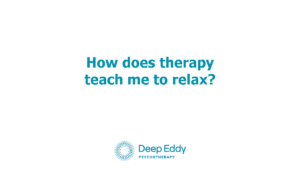Charlotte Howard, a therapist at Deep Eddy Psychotherapy in Austin, TX, talks about relaxation and keys to learning how to relax through therapy.
Making the Space to Relax
Relaxation is really about making the space to relax. If we’re under threat and there’s a bunch to do, our bodies naturally need to stay in high arousal and protect ourselves. If you can create a space to relax in, whether it’s just being alone and putting your hand on your heart, or taking a warm bath or something that soothes you, that’s likely to talk to the nervous system and help you relax.
Touch and tone are the nervous system’s language. That could look like a partner speaking to you in a nurturing way or you can speak to yourself in that gentle tone. Touch is very soothing—massage or being held—but it’s all about intention and creating a space in which your body feels comfortable and relaxed. Therapy creates a space where you feel safe to let your guard down. Often clients let out a sigh of relief when they arrive or even start crying immediately when a session starts without knowing why. Our bodies know when we have the space to relax and feel.
Therapy Gives You the Space to Let Out Your Feelings
A lot of relaxing has something to do with letting out your feelings. We tend to bottle things up. Perhaps we’re not comfortable crying at work, or some little stress happens, some disappointment, some rude thing someone said—the tendency is to just march on.

Relaxing in the Face of Anxiety
Often we become anxious about being anxious. One thing a lot of my clients run into with anxiety is that it’s self-perpetuating because they’re so anxious about being anxious. Especially if it’s a panic attack–those are really scary. People become terrified that they might have another one, but the problem is that that fear drives them to feel more anxious and it becomes more likely that they’re going to have another panic attack.
The Key is Being Okay with It
If you’re in the middle of a panic attack, of course, many will default to, “Make it stop, make it stop! Oh my gosh, I’m dying!” That’s going to freak your body out and it’s going to perpetuate what’s happening. The key to anxiety is to be okay with it. You are having a physiological experience and don’t need to do anything about it except notice it non-judgmentally.
Obviously, we want to take steps in your life to be able to heal anxiety and work on it. Good therapy can do that. There are a lot of techniques, but your overall attitude toward it needs to be embracing and that it’s okay for the anxiety to be there. The thing about embracing is that it’s soothing and makes it a lot less likely that you’re going to be anxious.
Starting Therapy in Austin, TX
We would love to invite you to make a complimentary call to discuss some of your options and determine whether Deep Eddy Psychotherapy in Austin, TX is the right fit for you and your situation. Please contact us using the links below or in the sidebar and share this post or video if you found it to be valuable. Together we can create a world of well-being and joy.
